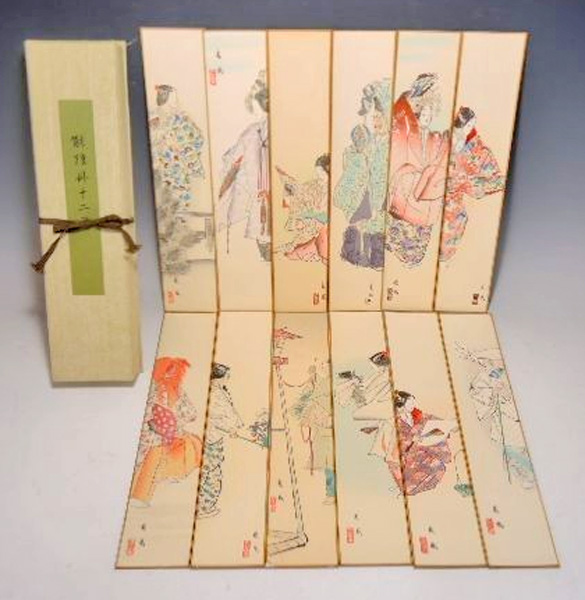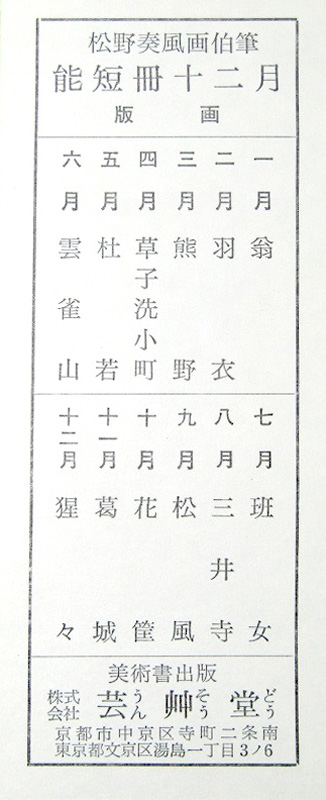About This Print and Twelve Months of Noh Tanzaku
For another print in this collection depicting this play see Sōshi Arai Komachi, saishiki (May) from the series Twelve Months of Noh Pictures.
last revision:
Twelve Months of Noh Tanzaku
From an undated set of twelve prints depicting twelve Noh plays, one play for each month, published by Unsōdō Publishing. This set likely preceded the set of prints with a similar name Twelve Months of Noh Pictures designed by Matsuno Sōfū (1899-1963) and his son Matsuno Hideyo (1936-2002). The print set, as stated in its title, was designed in the tanzaku format, a long and narrow pillar format originally used for poem cards and offerings. Each print presents the main character in a noh play in a truncated profile, allowing the viewer to complete the picture for each well known play.
In this set, reference image shown below, each print is mounted on a stiff board, the verso of which contains the prints title. The colophon for the set is shown below.
松野奏風画伯筆 能短冊十二月 版画
Twelve Months of Noh Tanzaku by Matsuno Sofu, Woodblock Prints
一月 翁; 二月 羽衣; 三月 熊野; 四月 草子洗小町; 五月 杜若; 六月 雲雀山; 七月 班女; 八月 三井寺;九月 松風; 十月 花筐; 十一月 葛城; 十二月 猩々
January Okina; February Hagoromo; March Yuya; April Sōshi Arai Komachi; May Kakitsubata; June Hibariyama; July Hanjo; August Miidera; September Matsukaze; October Hanagatami; November Kazuraki; December Shōjō
美術書出版
株式会社 芸艸堂
京都市中京区寺町二条南
東京都文京区湯島一丁目 3-6
Art Book Publishing
Unsōdō Public Company
Kyoto City address
Tokyo address
The Play - Sōshi Arai Komachi
Source: A Guide to No, P.G. O'Neill, Hinoki Shoten, 1929, p. 101-102.
Source: A Guide to No, P.G. O'Neill, Hinoki Shoten, 1929, p. 101-102.
"Komachi And The Forged Entry"By Kan-ami
"Komachi And The Forged Entry"
By Kan-ami
Third GroupAll schools
Act 1Characters:Waki - the poet Ōtomo no KuronushiKyōgen - his servantShite - the poetess Ono no Komachi
Act 2Characters:Ko-kata - the EmperorNochi-shite - Ono no KomachiNochi-tsure - Ki no TsurayukiNochi-tsure - two poets, Mibu no Tadamine and Kōchi no MitsuneNochi-tsure - two ladies-in-waitingWaki - Ōtomo no KuronushiWaki - the poet Ōtomo no Kuronushi
At a poetry competition in the presence of the Emperor, Ōtomo no Kuronushi's opponent is to be the poetess Ono no Komachi. Fearing that he will be defeated, Kuronushi plans to avoid this and to discomfit his rival at the same time. He and his servant manage to overhear the poem Komachi has written for the competition, and this he writes into a leaf from a copy of the Manyōshū anthology. When the poetess later recites this in the contest, he challenges it on that grounds that it is an old poem and produces the copy of the Manyōshū as proof. Komachi is overcome with humiliation at this, but with the help of Ki no Tsurayuki she obtains the permission of the Emperor to test the leaf in question by rinsing it with water. When she does so, the freshly written poem is washed away. Having had his trickery thus exposed, Kuronushi feels that the only course left for him is suicide, but the persuasion and forgiveness of Komachi and an order from the Emperor bring him back. To dispel any lingering awkwardness, Komachi entertains the company by performing a dance in honour of the Emperor and his reign.
Act 2
Characters:
Ko-kata - the Emperor
Nochi-shite - Ono no Komachi
Nochi-tsure - Ki no Tsurayuki
Nochi-tsure - two poets, Mibu no Tadamine and Kōchi no Mitsune
Nochi-tsure - two ladies-in-waiting
Waki - Ōtomo no Kuronushi
Waki - the poet Ōtomo no Kuronushi
Source: Japanese No Plays, Tourist Library Vol. 16,Zemmaro Toki, Japan Travel Bureau, 1954, p. 147.Matsukaze is one of the most celebrated of the Noh plays. The masks worn by the shite and the shite-zure [tsure] are of the koomote type representing beautiful young ladies, and the dance perform
1 Small vertical poem cards, approximately 36cm long x 6cm wide that may be decorated with colored designs, sprinkled with cut gold, silver or mica or covered with silk. The origins of this form may be connected to small slips of paper used for divining in ancient times. Another possible origin of tanzaku comes from the Heian period, when small rectangular pieces of paper, on which one poem was written, were used for poetry anthologies. The earliest extant examples from the 14c are of waka 和歌 poems on tanzaku white with no decoration. It was during the Muromachi period that tanzaku became highly decorated with cloud patterns overlaid with cut pieces of gold and silver. [source: Japanese Architecture and Art Net Users System.]
Print Details
| IHL Catalog | #2406 |
| Title | Sōshi arai komachi (April) 草子洗小町 (四月) title printed verso |
| Series/Album | Twelve Months of Noh Tanzaku 能短冊十二月 Noh tanzaku jūnikagetsu |
| Artist | Matsuno Sōfū (1899-1963) |
| Signature |  |
| Seal | 枩埜崇 Matsunosō [last character in seal unconfirmed] |
| Date | unknown, but likely 1950-early 1960s |
| Edition | unknown |
| Publisher | Unsōdō Publishing 芸艸堂 版 |
| Carver | unknown |
| Printer | unknown |
| Impression | excellent |
| Colors | excellent |
| Condition | fair - foxing mainly visible in background top and bottom |
| Genre | nishiki-e; Nōgaku zue [Noh play picture] |
| Miscellaneous | |
| Format | tanzaku |
| H x W Paper | 14 1/4 x 2 7/8 in. (36.2 x 7.3 cm) |
| Collections This Print | |
| Reference Literature |
12/7/2020 created




